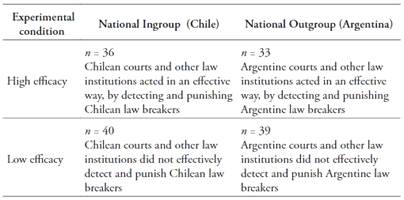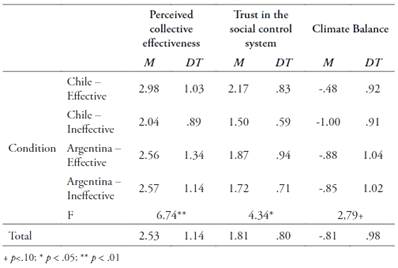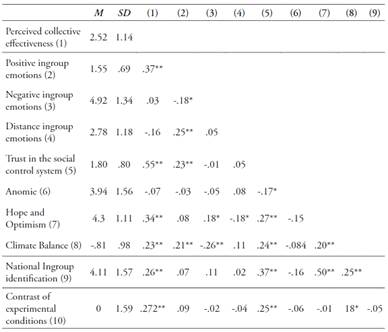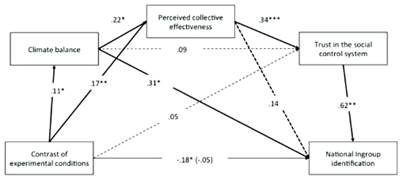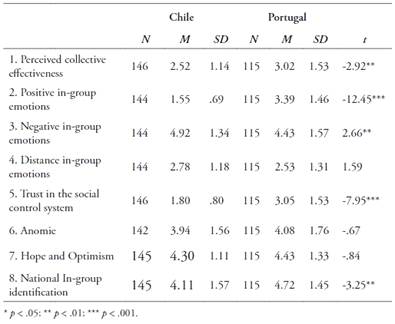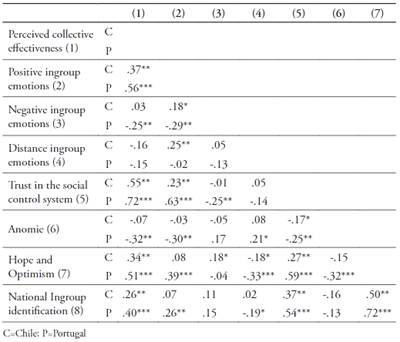This article will analyze, using an experimental approach with a Chilean sample to contrast a neo-Durkheimian approach to social control, how successfully dealing with deviant acts (i.e., acts of corruption) can increase social cohesion (Marques et al., 1998). The aim of this paper is to analyze how perceived social reactions to corrupt ingroup (versus outgroup) deviants contribute to social system stability. Durkheim posits that the social response to crime contributes to the maintenance of social cohesion. When a group or society punishes successfully their deviant members involved in crime, e.g. fraud and corruption, this act of social control clarifies and reinforces societal beliefs and norms among its members, and enhances social identification with the group and their values (Durkheim, 1893; 1895; Erikson, 1966).
Corruption is understood as the act that occurs as an abuse of public or collective goods for private gain (Transparency International, 2022). It can also be defined as the abuse of delegated power for private gain that diverts resources and undermines sustainable social development (Boehm et al., 2015). In addition, studies have revealed the transversal character of corruption within social groups: grand corruption is associated with the organizational context, and petty corruption is associated with structural factors, mainly with poverty (Poeschl & Ribeiro, 2012). Chile and Latin America in general have been strongly affected by corruption, namely with different official representatives being accused and proven to be involved in corruption: take, for instance, presidents Salinas de Gortari in Mexico, Fernando Collor de Mello in Brazil, Carlos Menem in Argentina, Carlos Andres Perez in Venezuela, Alberto Fujimori in Peru and the dictator Pinochet in Chile (Morales, 2009). However, according to data provided by Transparency International results (2021), Chile is the second Latin American country after Uruguay (assuming the 18st position in the ranking) with a lower perception of corruption (27rd position in the worldwide ranking). Interestingly, a close country, Argentina is ranked in the 96th position. Comparatively, Portugal and Spain (Latin European nations) occupy the rank 32 and 34th positions, respectively. In this paper, we will compare responses to corruption in the Chilean sample with a Portuguese sample in order to have a better descriptive understanding of the differences and similarities in the perception of the social system in the two Latin nations as compared to the Portuguese results.
Social control of corruption and national identity enhancement
Based on subjective group dynamics theory (SGDT; e.g., Marques, Páez, & Abrams, 1998), in a recent set of studies, Pinto et al. (2016) examined the effects of a group’s ability to effectively control its deviant corrupt members on participants’ ingroup identification. The basic premise of SGDT is that ingroup members who oppose generic, prescriptive norms (deviant members) threaten others’ positive social identity, meanwhile members who uphold these norms (normative members) bolster this identity (Marques et al.,1988). If both a prescriptive norm and ingroup membership are salient, people evaluate normative ingroup members more favorably and deviant ingroup members more unfavorably than normative and deviant outgroup members holding the same positions. This “black sheep effect” (BSE; Marques et al., 1988) occurs because people, in order to assure a positive social identity and revoke the threat posed by the presence of deviance within the ingroup, are motivated to differentiate more between ingroup members who support versus refute a prescriptive norm than between outgroup members taking the same positions (Marques & Paez, 1994). SGDT claims that social identification may be both an antecedent and a function of group-related beliefs, perceptions, and judgments, specifically regarding how the ingroup responds to deviance. Specifically, the level of differentiation between normative and deviant ingroup members is a function of ingroup identification, such that the more people identify with the ingroup, the more they tend to evolve in a BSE (see Branscombe et al., 1993). This intragroup differentiation is expected, in turn, to lead people to reinforce their identification with the group. It occurs because differentiation between normative and deviant members not only reflects but also has the potential to increase the perceived intragroup consensus around normative standards that legitimate positive ingroup differentiation.
Group’s efficacy and ability to respond to deviance (e.g. derogating or punishing its deviant members) is, thus, an important mechanism through which individuals increase their identification with the ingroup (Pinto et al., 2016). While a bidirectional relation between group efficacy and social identification has been posited, experimental data suggest that it is group efficacy that influences social identification (Van Zomeren et al., 2010). In this work, we posit that awareness of corruption as an instance of ingroup deviance increases social identification to the extent that the group is perceived to react (punish) effectively to the deviants. In these conditions (with the operation of an effective social control), deviance should end up contributing to enhancing social cohesion, by triggering the mobilization of positive emotional arousal when they learn that the ingroup is effective in implementing social control on deviant members, which, consequently, increases social identification. As Durkheim (1893; 1895) posits, the existence of delinquents and their punishments are ritualistic activities nurturing belongingness to a moral community as we have previously stated in the introduction.
Aligned with these ideas, Pinto et al (2016) conducted two studies in which participants were informed that the national ingroup (vs. outgroup) dealt with deviant occurrences in an effective (vs. ineffective) way. Induced ingroup effectiveness increased participants’ ingroup identification, reinforced their trust in the ingroup’s social control system, and evoked a more positive emotional climate. Conversely, induced ingroup ineffectiveness generated a negative emotional climate and weakened participants’ ingroup identification. No effects emerged in the outgroup conditions. In a third correlational study, Pinto et al (2016) found that perceived national ingroup effectiveness predicted ingroup identification, through collective emotions (i.e., emotional climate, ingroup anomie, ingroup emotions) and through trust in the group’s social control system. Another similar experimental research developed in Latin America established that people in the experimental condition of higher ingroup efficacy in the control of corruption had a greater interest in politics, a more excellent perception of effectiveness in the management of corruption, and a better socioemotional climate balance. Also, it is noted that identification with the national ingroup increased only in people who previously trusted the justice system (judiciary) and who were informed of high ingroup efficacy (Chaparro et al., 2021). In our work, we present an experimental study in which we contrast the last described sequential model. Congruently with the dual model of paths towards collective mobilization (Van Zomeren, et al, 2010), we posit the emergence of one affective and another instrumental process conducive to positive outcomes in social cohesion and identification. The appraisal that the ingroup has effectively dealt with deviance arouses ingroup-based positive emotions and evokes a positive emotional climate or perceived emotions and actions tendencies in other ingroup members (De Rivera & Paez, 2007). Not only personal feelings related to group members but also collective emotions are relevant for similar social dynamics (Von Scheve & Salmela, 2014). Indeed, collective emotions were found to mediate between group efficacy and social integration (Paez et al., 2013; Bar-Tal et al., 2007). A positive emotional profile of ingroup emotions and collective emotions, in particular, collective hope (Bar-Tal et al, 2007) was found to increase social identification and cohesion (Paez et al., 2013). On the other hand, regarding an instrumental line of reasoning, the evidence that one’s group is able to deal with deviation provokes an enhanced sense of collective efficacy conducive to social integration or increase social trust and identification (Van Zomeren et al, 2010).
This paper expands Pinto et al. (2016) studies by including huge dependent variables that allow us to contrast their sequential model. Following the classical paradigm of subjective group dynamics, a two-by-two design examines the effect of group membership - ingroup (Chile) versus outgroup (Argentina) - and of group perceived effectiveness - effective versus ineffective - to cope with corruption, on ingroup identification, through perceived collective efficacy, trust in the social control and collective emotions. Induced ingroup effectiveness should evoke a higher collective efficacy, confidence in the means of social control, and an increased national ingroup identification. Conversely, induced ingroup ineffectiveness should generate a negative emotional climate, evoke a lower collective efficacy and decrease trust in social control, and should weaken participants’ ingroup identification by this emotional path. This profile will emerge more strongly in the ingroup than in the outgroup condition. Effective outgroup condition is supposed to provoke weak negative outcomes because of a negative upward social comparison, while low outgroup efficacy is supposed to provoke a weak positive outcome, by positive downward social comparison.
The second goal is to compare the perception of social control, corruption, and emotional climate between the Portuguese and Chilean samples. Both student samples are similar, and despite not being national representative samples, they can help to look at how people perceive this social issue in a Latin American and a European country. In addition, we want to contrast if associations found in Portugal are replicated in Chile.
Method
Participants and Design
Participants were 148 Psychology and Social Work students (30% of male participants) at the University of Valparaiso, aged from 17 to 21 years old (Mage = 19.18;SD= 2.26). They were randomly assigned to experimental conditions. The number of participants in each one ranged between 33 and 40 (see Table 1). Sex and age did not differ across experimental conditions.
The design was a 2 (Effective vs. Ineffective Target Group) X 2 (Ingroup vs. Outgroup Target Group) full between-participants (see Table 1).
Measures
Participants answered 3 sets of items measuring: a) collective emotions: ingroup emotions, hope emotional climate; b) social control-related measures: perceived collective effectiveness, trust in the social control system, and c) National ingroup identification. All the scales were measured in 7-point scales ranging from 1=Not at all to 7=Very much so, except for the emotional climate (EC) scale that uses five-point Likert scales, ranging from 1=Nothing to 5=Very much.
a) Collective Emotions
Ingroup emotions. Participants answered to three item subsets corresponding to i) negative emotions -shocked, surprised, ashamed- (Cronbach’s α = .62); ii) positive emotions -trustful, secure, hopeful, happy, and proud- (Cronbach’s α = .71); and iii) distance emotions -indifferent, distant, unconcerned- felt regarding the national ingroup (Cronbach’s α = .79). These measures were used by Pinto et al. (2015).
Hope, optimism and fatalistic anomie. Participants answered two sets of items measuring, respectively, their perception of an existing climate of hope and optimism, and of an existing state of anomie in their group. Items measuring the perceived climate of hope and optimism were: (1) It is worth struggling for social justice in Chile; (2) I believe that the Chilean people will overcome their difficulties; (3) In Chile, people can feel safe; and (4) The Chilean people are committed to fighting for a better country (Cronbach’s α = .70). Items measuring perceived anomie were: (1) People cannot achieve what they deserve by legal means, and (2) In Chile everything goes (Cronbach’s α = .60). Pinto et al. (2016) used these measures.
Emotional climate. Items measuring positive emotional climate and items measuring negative emotional climate assessed perceived emotional climate. This scale CEPN has been widely used in previous studies rendering good reliability and validity (Páez et al., 1997; Paez et al., 2013). Positive emotional climate items were: 1) The affective climate or general mood of the country is very good; (2) The general mood or social climate is (a) Hopeful, (b) Solidary, of mutual help, (c) of trust in the institutions; (g) Happy, trustful; (h) Calm (Cronbach’s α =.60). Negative emotional climate items were: (d) fear, anxiety, (e) anger, hostility, aggressiveness among people; and (f) sadness, passivity, low morale (Cronbach’s α = .67). A positive minus negative EC is used as an index of collective affect balance (Climate balance); such that positive scores measure a predominance of positive emotions, and negative scores measure a predominance of negative emotions.
b) Social Control Related Measures
Perceived collective effectiveness. Participants then answered five items used previously (Pinto et al, 2016): (1) the Chilean society can effectively control fraud when it occurs; (2) Chilean society can effectively trial the people who are involved in fraud crimes; (3) People who commit fraud will be trialed by the Chilean system; (4) Fraud cases will be effectively prosecuted by Chilean courts; and (5) The Chilean system effectively punishes fraud (Cronbach’s α= .86). This variable is conceived off as a manipulation check but also as the participant´s perception of the main variable.
Trust in the social control system. This was measured by four items (Pinto et al, 2016): (1) We should have more trust in our political leaders; (2) Our laws against fraud are effective; (3) Our justice system can effectively prevent future cases of fraud; and (4) I believe that the Chilean justice system is effective against corruption (Cronbach’s α= .77).
c) National Ingroup identification
Five items measured participants’ identification with the national ingroup (based on Pinto et al, 2015): (1) I feel I am Chilean (2) Being Chilean is an important part of my identity; (3) I am proud of being Chilean, (4) I feel connected with the other Chilean; and (5) My faith and my future are associated with those of the Chilean people (Cronbach’s α = .89).
Procedure
Inspired by Pinto et al. (2016) scenario, we exposed participants to four narratives with a standard structure, mentioning some of the corruption cases that occurred in Chile or Argentina last year. Also, we show them a supposed study that identified 856 cases of corruption in 2012. In order to increase psychological realism, some examples of corruption cases were given. We varied the country where the study was conducted either Chile (Ingroup condition) or Argentina (Outgroup condition), as well as the level of efficiency of justice: for the state of High Efficiency, participants were informed that 95% of the cases were resolved satisfactorily, whereas for the condition of Low Efficiency only 5% of cases were satisfactorily resolved. The cover story made explicit that those corrupted were ingroup members (Chileans) or outgroup members (Argentineans).
Participation was informed, voluntary, and formalized through the signing of an informed consent document. The questionnaires were answered in sessions of 30 minutes, individually. People did not obtain direct benefits for their participation in the study. The research was reviewed and approved by the Bioethics Committee of the Faculty of Medicine of the University of Valparaíso (Chile).
Results
We conducted an omnibus analysis of variance and contrast analysis of means to contrast the hypothesis. Omnibus Anova found two significant interactions and one marginally significant (see Table 2).
Perceived collective effectiveness F(1,142)= 6,74, p=.010, ηp2 =.045), Trust in the social control system F(1,142)= 4,34, p=.039, ηp2 =.030), and Climate balance F(1,142)= 2,79, p=.097, ηp2 =.020) were higher in the effectiveness ingroup condition and lower in the ineffectiveness ingroup condition, as compared to the outgroup conditions.
It is important to remark that the general level of Perceived collective effectiveness (M = 2.53) and Trust in the social control system (M = 1.81) were below scale middle-point. Moreover, climate balance was negative. These results show that people perceive more negative than positive collective emotions, reflecting a critical view of the ingroup society.
Focused contrast analysis was ruled (Rosenthal, 1991), attributing values to each condition that follow our hypothesis and are consistent with SGD assumptions: a 2 weight for the ingroup effectiveness condition representing the positive ideal conditions for ingroup cohesion; a 1 for outgroup ineffectiveness representing a target of comparison that would legitimate a positive value for the ingroup positive value by positive social comparison; -1 in the effectiveness outgroup condition, a condition that presents a target that would be more threatening to the attainment of a positive ingroup value, providing a negative social comparison result, and -2 in ineffectiveness ingroup condition, that represents the highest threat to a positive national collective identity. This new variable, combining the four conditions hierarchized regarding the potential of each condition for a positive national identity, was denominated “Experimental Manipulation”. Contrast analysis has strong statistical power and allows contrasting specific models above classic Anova (see Rosenthal, 1991). A correlation was used as an effect size estimator (Rosenthal, 1991). Weighted contrast of experimental conditions show significant effects for Perceived collective effectivenessr(141) = .27,p< .05, Trust in the social control system,r(146) = .25,p< .01, and Climate balancer(141) =.18,p< .05.No effect was found for the other variables.
National ingroup identification correlates, as expected, with Perceived collective effectiveness,r(145) =.26,p<.01; Trust in the social control system r (145)=.37,p<.01, Climate balance, r (140) =.25, p<.01, and with Hope and optimism,r (144)=.50,p<.01. Perceived collective effectiveness, Trust in social control, and Climate balance were also associated. Ingroup positive emotions correlate positively with Collective effectiveness, Trust in social control, and Climate balance, but not with National identification. Negative ingroup emotions correlate negatively with Hope and optimism and with Climate balance, but not with National identification. Anomie correlates negatively with Trust in the social control system (see correlations in Table 3).
Mediational analysis
In the model, we included variables that were used in Pinto et al. (2015) model, that were influenced by our manipulations, and that correlates with identification. To test our model, we used a serial mediation model analysis PROCESS, model 6, (Hayes, 2013) with 10000 bootstrap estimates. In our model, we considered Experimental manipulation as the predictor variable (using previously described weights 2 ingroup effectiveness and so on), Climate balance, Collective effectiveness, and Trust in social control as sequential mediators (following the presented order), and National identification as the dependent measure of the model. It is important to remark that the direct effect of Experimental manipulation on National identification is not significant, which does not preclude the conduction of the analysis, and the emergence of a significant indirect effect (see Hayes (2009) for a critic of classical Baron and Kenny position on mediational analysis).
Results show that Experimental manipulation has a significant direct effect on Climate balance as well as on Perceived collective effectiveness (see Figure 1). Climate balance showed a significant direct effect on National identification and Perceived collective effectiveness. The last variable has a significant direct effect on trust in the social control system, and on national ingroup identification.
The bootstrap analysis yielded three significant indirect effects of the Experimental manipulation on National identification. First, contrast of experimental conditions reinforces National identification through Climate balance (b= .033,SE= .02, 95% CI: .003 to .085). Second, contrast of experimental conditions predicted Perceived collective effectiveness and trust in social control, which, in turn, predicted National identification (b= .035,SE= .016, 95%CI: .011 to .077). Finally, contrast of experimental conditions enhances national identification through Climate balance, Perceived collective effectiveness and Trust in social control system (b= .0055,SE= .004, 95%CI: .001 to .019). Globally, our model was supported by data. In brief, the more positive the context for the ingroup positive national identity (Experimental manipulation), the more positive the Climate Balance, the more the national group was perceived to be effective in dealing with corruption, and the more participants show trust in the national social control system. In turn, these conditions provided increased national identification.
Means, standard deviations and correlations of Chile and Portugal
Finally, mean comparisons were ruled using means and SD of Pinto et al. (2015) study three.
Mean comparisons between Portuguese and Chilean students samples showed that Portuguese, although having a lower position in the International Transparency corruption index, report a less negative view of collective effectiveness and trust in social control, than the Chilean sample. However, it is important to remark that both samples appraise critically their social system - both means are below the theoretical mean of four. Furthermore, Chilean report lower positive ingroup emotions, higher negative ingroup emotions, and lower national identification. National identification, in both samples, was slightly above the theoretical mean point. However, no differences were found for negative ingroup distance or resignation emotions, anomie, and hope, being the last one also slightly above the theoretical mean.
Correlations (see Table 5) showed that perceived collective effectiveness was associated with positive ingroup emotions, collective hope, and national identification, and a comparison of independent correlations did not find differences. Positive ingroup emotions correlates positively with collective hope and with trust in the social control system, but strongly in Portugal than in Chile -z = 2.61, p < .01 and z = 3.9, p < .00 respectively. Also, it correlates negatively with fatalistic anomie and positively with national identification in both countries, but significantly only in Portugal - z not significant.
Positive ingroup emotions correlate, in both nations, with collective effectiveness and other outcomes, but the associations were stronger in Portugal. Negative ingroup emotions correlate negatively with perceived effectiveness in Portugal but not in Chile - z = 3.60, p < .001 and correlate positively with positive ingroup emotions in Chile and negatively in Portugal - differences were significant, - z = 3, 78, p < .001. It also correlates negatively, strongly, and significantly with trust in the social control system only in Portugal. The opposite occurs with collective hope that was inversely correlated with negative ingroup emotions only in Chile - a comparison of correlations did not find differences. Moreover, collective fatalistic anomie correlates negatively with perceived effectiveness, more strongly in Portugal than in Chile - z=2,05,p<.05. Positive ingroup emotions correlate positively with social trust, with collective hope and national identification, stronger in Portugal than in Chile - z=3.9 p<.001, z= 2,61,p<.01 respectively.
Distance ingroup emotions correlate negatively with collective hope in both nations and with national identification only in Portugal- no significant differences were found comparing correlations. Trust in the social control system correlates negatively with anomie and positively with national ingroup identification and collective hope, but we only found significant differences between the correlations regarding collective hope, z = 3.16, p < .001. On the other hand, anomie correlates negatively with collective hope in Portugal but not in Chile, and collective hope correlates positively with national ingroup identification in both nations - differences between nations were significant, - z=2,82, p<.001. In brief, correlations between variables were usually stronger in the Portuguese than in the Chilean sample.
Discussion
This study replicates findings that induced ingroup effectiveness evokes a more positive emotional climate, as well as enhances collective effectiveness, and reinforces trust in the ingroup’s social control system; whereas induced ingroup ineffectiveness generates a more negative emotional climate and more negative outcomes as compared to outgroup conditions. However, at odds with Pinto et al. studies, ingroup effectiveness generates only indirectly higher ingroup identification. Indeed, and in a similar vein to Pinto et al.’s Study 3’s mediation analysis, perceived ingroup effectiveness predicted ingroup identification through enhanced collective effectiveness that, in turn, increases trust or confidence in the social control system, controlling the influence of emotional climate. Moreover, results also support Pinto et al.’s model through a sequential mediational analysis (reversed models were tested but they fit worse with data).
First, induced national ingroup effectiveness decreases negative collective emotions; we cannot say that our sample showed a positive emotional climate. Indeed, in this study, participants perceived higher negative than positive emotions, and they reported as a general trend a negative climate balance. Although it might be strange, since Portugal has a lower ranking position on corruption than Chile and still showed a higher emotional climate, we believe that this negative balance may be determined by other factors such as social conflicts and low quality of life that is more present in Latin American nations (Páez et al., 2013). Portugal belongs to the EU, which can explain the higher positive climate as compared to Chile. This idea is consistent with results found by Paez et al. (2013), which previously showed that even Southern European nations (such as Spain and Portugal) have a more positive climate than Latin American nations.
Second, an emotional path between increased effectiveness and social cohesion and identification was supported, because positive climate balance (or a less negative emotional climate) mediated between ingroup effectiveness and national identification. This is an important result because it supports the idea that social identification is partially based on a collective emotional process towards the national group and not on personal emotions (such as ingroup emotions). Indeed, the so-called intergroup emotions are personal emotions regarding the ingroup and outgroups, not true collective emotions. They are less relevant for social dynamics than emotional climate or collective emotions, which are shared and felt by a majority of ingroup members (Von Scheve & Salmela, 2014; Bar-Tal et al., 2007; De Rivera & Paez, 2007). Results also support that collective emotions mediate between group efficacy and increased social cohesion and identification (Paez et al., 2013). However, collective hope did not play a relevant role in our study probably because a positive emotional climate buffers their association with perceived effectiveness (Bar-Tal et al., 2007).
Third, a more “instrumental-behavioral” path was also supported, because even controlling for EC, ingroup effectiveness predicted perceived collective efficacy, that increased trust in social control, and via this perceived collective behavior process, reinforced national identification. Results showed that exposure to evidence that one’s group is able to deal with deviation induces an enhanced sense of collective efficacy that in turn evokes social trust and indirectly reinforces national identification (Van Zomeren et al, 2010).
Considering the general critical view regarding the national ingroup obtained in Latin samples, it seems that induced ingroup effectiveness in controlling corruption might be a relevant tool to directly or indirectly reinforce national cohesion. As we said previously, more than reinforcing a positive view of social control mechanisms, induced ingroup effectiveness decreases a dominant critical view of collective effectiveness and confidence in social control, and reinforces individuals’ commitment to society and national institutions. On the other hand, when controlling for all these mediators, experimental manipulation showed a significant direct effect on national identification. This effect reveals that participants in the more threatening and negative ingroup condition reported a higher level of national identification. This might be perceived as contradictory to our claims. Nevertheless, it is important to remark that the level of national identification, in accord with the critical view of Chilean society, was not very high. Indeed, Pinto et al. suggest that the level of national identification might function as a cyclical predictor and dependent variable of all processes. Results suggest that when controlling perceived collective emotional and behavioral responses associated with successful social control of deviance, participants in the negative ingroup ineffective condition reinforced national identification. This means that a threatened ingroup tended to trigger higher national identification than a secure ingroup. However, when people were able to acknowledge a perceived improvement of collective emotions and behaviors, and a higher trust in the national institutions, such a compensatory original response of being more identified with the threatened ingroup (“right or wrong [and probably strongly when is wrong and could be criticized] my country is my country”) disappeared. We may think that more relevant stimuli, as well as more careful and securing information regarding the ingroup, could reverse the original pattern (of an anxious identification with the ingroup) towards a more confident, hopeful, committed attitude regarding a positive, and secure ingroup.
With respect to the comparative perception of society in Chile and Portugal, the latter sample reports a less negative view of the society, but both samples share a slightly high collective hope and optimism and lower distancing from ingroup emotions like indifference, suggesting that the perception is not negative. National identification in the samples of university students, being higher among Portuguese was not so strong and only slightly above the theoretical mean, showing that the sense of belongingness to the national society is only moderate. More importantly, confirming studies showing that a critical view of institutions (i.e. justice system) is a general trend, participants reported a perception of collective ineffectiveness and mistrust in social control, being even more negative amongst Chileans than Portuguese are.
Perceived collective effectiveness was associated in Portugal and Chile with a similar effect size with positive ingroup emotions, collective hope, and national identification - and negatively but not significantly in both nations with distance ingroup emotions. Trust in the social control system correlates positively with national ingroup identification in both nations with similar effect sizes. These results are important because confirm that the most important associations are stable in both nations as we expected. Positive ingroup emotions correlate positively with collective hope and with trust in the social control system, and negatively with fatalistic anomie, and positively with national identification in both countries, but more intensively in Portugal. In the same vein, negative ingroup emotions correlate negatively with perceived effectiveness and trust in the social system in Portugal but not in Chile. Negative ingroup emotions were associated with low positive emotions and were associated with efficacy in Portugal, but not in Chile - negative emotions were associated with positive ingroup emotions. More importantly, personal negative ingroup emotions were unrelated to perceived effectiveness in Chile. We can conclude that personal ingroup emotions play a similar role but with a stronger association with other outcomes in Portugal. It is possible that by being a more collectivist culture, Chile helps to differentiate between personal and collective emotions (van Kleef & Fischer, 2016).
Otherwise, the results are similar to those obtained in a study conducted in Peru, where the experimental conditions in the high efficacy condition improved the socioemotional climate, and increased the perception of efficacy in the control of corruption and national identity (Chaparro et al., 2021). Although they presented some differences in the analyses, the experimental design, and the sample. In relation to the analyses, the present work used a sequential mediation that allowed appreciation of the relationship between the variables of the study, establishing national identification as the dependent variable. Also, the present work introduced conditions that considered the presence of an outgroup (Argentina), which allowed the establishment that perceived collective efficacy and trust in the social control system were higher in the ingroup efficacy condition and lower in the ingroup inefficacy condition, the outgroup condition not being relevant. Finally, it is important to point out that, although both studies use different samples (general population in the Peruvian case and university students in our case), they present similar effects in the high efficacy conditions, which shows the replicability of this experimental design in different contexts and populations. In this sense, the present study did not aim to project the results to the population, as would be the case with a probability sample, but rather to test the effects of the experimental design in a specific and homogeneous group (university students) to ensure control of the variables.
Concluding, institutional actions that increase collective effectiveness in dealing with corruption emerged as a mechanism of regulation and improvement of collective emotions, and also as a factor that enhances confidence in the national ingroup, through emotional and instrumental processes, emerging as a facilitator of the social cohesion reinforcement (i.e., national identification).














